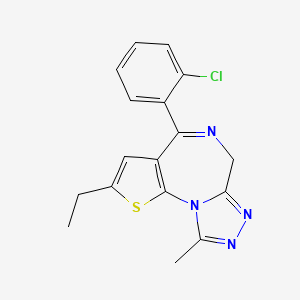



1. Etizolam, 14c-labeled
2. Y 7131
3. Y-7131
1. 40054-69-1
2. Depas
3. 4-(2-chlorophenyl)-2-ethyl-9-methyl-6h-thieno[3,2-f][1,2,4]triazolo[4,3-a][1,4]diazepine
4. Sedekopan
5. Y-7131
6. A76xi0hl37
7. 4-(o-chlorophenyl)-2-ethyl-9-methyl-6h-thieno(3,2-f)-s-triazolo(4,3-a)(1,4)diazepine
8. Ahr3219;y7131
9. Ncgc00182031-01
10. Etizolamum
11. Etizolam [inn:jan]
12. Etizolamum [inn-latin]
13. Ahr 3219
14. 7-(2-chlorophenyl)-4-ethyl-13-methyl-3-thia-1,8,11,12-tetraazatricyclo[8.3.0.0^{2,6}]trideca-2(6),4,7,10,12-pentaene
15. Brn 0572740
16. Unii-a76xi0hl37
17. Sedekopan (tn)
18. Etizolam [inn]
19. Etizolam [jan]
20. Etizolam [mi]
21. Etizolam (jp17/inn)
22. Dsstox_cid_3030
23. Etizolam [mart.]
24. Etizolam [who-dd]
25. 6-(o-chlorophenyl)-8-ethyl-1-methyl-4h-s-triazolo(3,4-c)thieno(2,3-e)(1,4)-diazepine
26. 6-(o-chlorphenyl)-8-aethyl-1-methyl-4h-s-triazolo(3,4-c)thieno(2,3-e)(1,4)diazepin [german]
27. 6h-thieno(3,2-f)(1,2,4)triazolo(4,3-a)(1,4)diazepine, 4-(2-chlorophenyl)-2-ethyl-9-methyl-
28. 8-ethyl-6-(o-chlorophenyl)-1-methyl-4h-s-triazolo(3,4c)thieno(2,3e)-1,4-diazepine
29. Dsstox_rid_76838
30. Dsstox_gsid_23030
31. Schembl42920
32. Zinc1402
33. Chembl1289779
34. Dtxsid0023030
35. Chebi:31583
36. Ahr3219
37. Etizolam 0.1 Mg/ml In Methanol
38. Etizolam 1.0 Mg/ml In Methanol
39. 4c66
40. Hms3652n06
41. Bcp22893
42. Hy-b0677
43. Tox21_112931
44. S4276
45. Akos022185397
46. Db09166
47. Ds-3112
48. 4h-s-triazolo(3,4-c)thieno(2,3-e)(1,4)-diazepine, 6-(o-chlorophenyl)-8-ethyl-1-methyl-
49. 6-(o-chlorphenyl)-8-aethyl-1-methyl-4h-s-triazolo(3,4-c)thieno(2,3-e)(1,4)diazepin
50. Ncgc00182031-05
51. Cas-40054-69-1
52. Sw219903-1
53. A14257
54. D01514
55. Q409966
56. Sr-01000883960
57. Sr-01000883960-1
58. Etizolam Solution, 1.0 Mg/ml In Methanol, Ampule Of 1 Ml, Certified Reference Material
59. 4-(2-chlorophenyl)-2-ethyl-9-methyl-6h-thieno[3,2-f] [1,2,4]triazolo[4,3-a] [1,4]diazepine
60. 4-(2-chlorophenyl)-2-ethyl-9-methyl-6h-thieno[3,2-f][1,2,4]-triazolo[4,3-a][1,4]diazepine
61. 7-(2-chlorophenyl)-4-ethyl-13-methyl-3-thia-1,8,11,12-tetraazatricyclo[8.3.0.02,6]trideca-2(6),4,7,10,12-pentaene
62. 7-(2-chlorophenyl)-4-ethyl-13-methyl-3-thia-1,8,11,12-tetrazatricyclo[8.3.0.02,6]trideca-2(6),4,7,10,12-pentaene
63. H4c
| Molecular Weight | 342.8 g/mol |
|---|---|
| Molecular Formula | C17H15ClN4S |
| XLogP3 | 2.6 |
| Hydrogen Bond Donor Count | 0 |
| Hydrogen Bond Acceptor Count | 4 |
| Rotatable Bond Count | 2 |
| Exact Mass | 342.0705954 g/mol |
| Monoisotopic Mass | 342.0705954 g/mol |
| Topological Polar Surface Area | 71.3 Ų |
| Heavy Atom Count | 23 |
| Formal Charge | 0 |
| Complexity | 474 |
| Isotope Atom Count | 0 |
| Defined Atom Stereocenter Count | 0 |
| Undefined Atom Stereocenter Count | 0 |
| Defined Bond Stereocenter Count | 0 |
| Undefined Bond Stereocenter Count | 0 |
| Covalently Bonded Unit Count | 1 |
Indicated for the treatment of generalized anxiety disorder with depression, panic disorder and insomnia.
Etizolam is a CNS depressant with anxiolytic, anticonvulsant, sedative-hypnotic and muscle relaxant effects. It acts on the benzodiazepine site of the GABA-A receptor as an agonist to increase inhibitory GABAergic transmission throughout the central nervous system. Studies indicate that etizolam mediates its pharmacological actions with 6 to 10 times more potency than that of diazepam. Clinical human studies performed in Italy showed clinical effectiveness of etizolam in relieving symptoms in patients with generalized anxiety disorders with depressive symptoms. Etizolam also mediates imipramine-like neuropharmacological and behavioral effects, as well as minor effects on cognitive functioning. It is shown to substitute the actions of a short-acting barbiturate, pentobarbitol, in a drug discrimination study. Etizolam is an antagonist at platelet-activating-factor (PAF) receptor and attenuates the recurrence of chronic subdural hematoma after neurosurgery in clinical studies. It is shown to inhibit PAF-induced bronchoconstriction and hypotension.
Tranquilizing Agents
A traditional grouping of drugs said to have a soothing or calming effect on mood, thought, or behavior. Included here are the ANTI-ANXIETY AGENTS (minor tranquilizers), ANTIMANIC AGENTS, and the ANTIPSYCHOTIC AGENTS (major tranquilizers). These drugs act by different mechanisms and are used for different therapeutic purposes. (See all compounds classified as Tranquilizing Agents.)
N - Nervous system
N05 - Psycholeptics
N05B - Anxiolytics
N05BA - Benzodiazepine derivatives
N05BA19 - Etizolam
Absorption
Etizolam is well absorbed from the intestines with a biological bioavailability of 93% following oral administration. After a single oral dosing of 0.5mg etizolam, it takes approximately 0.9 hours to reach the peak plasma concentration of 8.3 ng/mL.
Route of Elimination
In a rat study, the amounts of etizolam excreted was 30% in urine was 70% in feces, while the values in a mouse study were 40% in urine and 60% in feces.
Volume of Distribution
Apparent distribution volume was 0.9 0.2 L/kg following a single oral doing of 0.5mg etizolam.
Biotransformation of etizolam is extensive and involves hydroxylation and conjugation. The main metabolite formed via 1'-hydroxylation is -hydroxyetizolam which retains pharmacological activity comparable to that of the parent drug, indicating that the action of metabolites may contribute to the clinical effects of etizolam. CYP3A4 is predicted to be the main CYP enzyme responsible for mediating etizolam metabolism. CYP2C18 and CYP2C19 are also involved in the metabolic pathways.
Etizolam has known human metabolites that include 7-(2-chlorophenyl)-4-ethyl-13-methyl-3-thia-1,8,11,12-tetrazatricyclo[8.3.0.02,6]trideca-2(6),4,7,10,12-pentaen-9-ol and alpha-Hydroxyetizolam.
S73 | METXBIODB | Metabolite Reaction Database from BioTransformer | DOI:10.5281/zenodo.4056560
The average elimination half life of etizolam following a single oral dose of 0.5mg is 3.4 hours but may be increased up to 17 hours depending on the rate of metabolism. The main metabolite -hydroxyetizolam displays a longer elimination half life of 8.2 hours.
Etizolam is selectively a full agonist at GABA-A receptors to increase GABAergic transmission and enhance GABA-induced Cl- currents. It is reported to bind to the benzodiazepine binding site which is located across the interface between the alpha and gamma subunits. Benzodiazapines are reported to only bind to receptors that contain gamma 2 and alpha 1/2/3/5 subunits. Alpha-1-containing receptors mediate the sedative effects of etizolam whereas alpha-2 and alpha-3 subunit-containing receptors mediate the anxiolytic effect. Etizolam shows high potency and affinity towards GABA-A receptor with alpha 1 beta 2 gamma 2S subunit combination. By binding to the regulatory site of the receptor, etizolam potentiates GABA transmission by facilitating the opening of GABA-induced chloride channels. Etizolam is a specific antagonist at PAFR. It inhibits PAF-induced platelet aggregation by inhibiting PAF binding to the receptors located on the surface of platelets with an IC50 of 22nM.